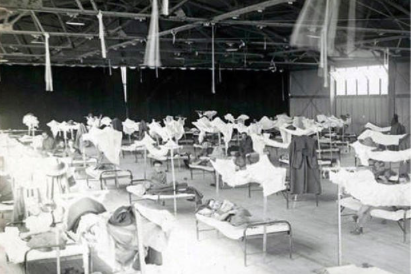
42nd Infantry Division, National Guard, Camp Upton, Long Island, NY, October 1918, 404 died, 6000 took ill. (Photo courtesy NARA.gov)
In January and February of 1918, a flu virus quietly spread through sleepy Haskell County, Kansas, with a human population of 1,720 dispersed over nearly 600 acres. By the time the Spanish Flu burnt itself out globally, over 21,000,000 people would be dead.
As the virus worked its way through Haskell County, young American soldiers were arriving at Camp Funston, later renamed Fort Riley, Kansas for service in World War One. On March 4th, Camp Funston reported its first case of the flu and within three weeks 1,000 troops of over 56,000 were ill. With resources stretched to the limit, senior leadership at Camp Funston alerted the United States Public Health Service to the danger. Alarm rose at the realization that soldiers had been sent throughout the country in preparation for deployment overseas. On March 18th, Camps Forrest and Greenleaf in Georgia reported incidents of the flu and by April most of the 36 main camps in the United States also reported outbreaks.
Communication in the early 20th Century not being what it is today, there was limited notification to initiate testing, tracing, and isolating of soldiers who were already bound for Europe. That same April, 1918, news came of flu in Brest, France, one of the main landing ports for US troop ships. And so, the Spanish Flu of 1918 would go down as the single largest killer of human beings through disease in known history.
Late summer brought a breather only to see the flu come roaring back with a vengeance in the Fall of 1918. The National Guard’s first brush with the epidemic came in September at Camp Upton in Long Island, NY. The 42nd Infantry Division, aka the Rainbow Division, was so named because it was comprised of soldiers from 26 separate States and the District of Columbia. Most famous for their part in the offensives against the Germans in the Meuse-Argonne, the 42d began its time as the first National Guard division to lose soldiers stateside to the Spanish flu. By October, 1918, 404 men had died out of over 6000 admitted to hospital with flu.
How to account for such a high count in the United States beyond the military? The Army Camp hospitals were so overwhelmed that soldiers had to be taken to local civilian hospitals where the flu virus ran rampant. And so, what began in a sleepy, southwestern Kansas county ran rampant across the globe leaving death in its wake. By the end of the pandemic, all told, at least 21,000,000 people would lose their lives.
*Did you know: That the Spanish Flu got its name because Spain was neutral in World War One? Newspapers in participating countries did not report the flu so as to avoid damaging morale. Spain reported it fully and so, to readers, it appeared the flu originated in Spain.
Special thanks to the National Guard Bureau at https://www.nationalguard.mil/News/News-Features/Article/1616713/flu-outbreak-killed-45000-us-soldiers-during-world-war-i/ (accessed 20 May 2020) and the National Institute of Health (NIH) at https://www.ncbi.nlm.nih.gov/pmc/articles/PMC340389/ (accessed 20 May 2020).

